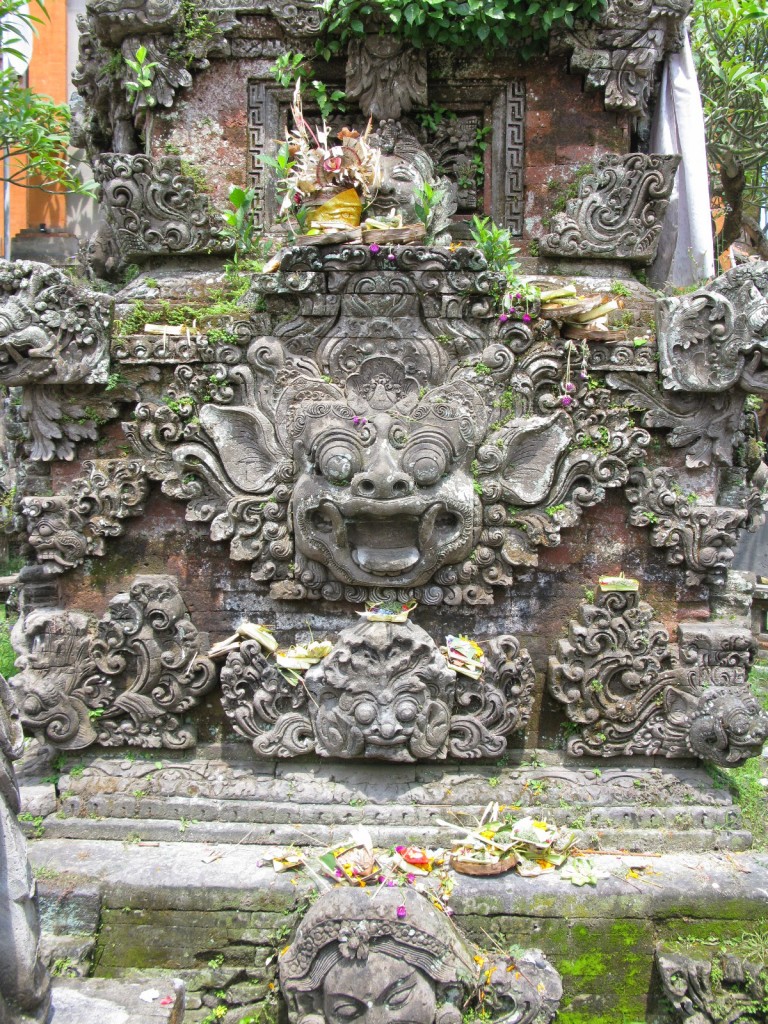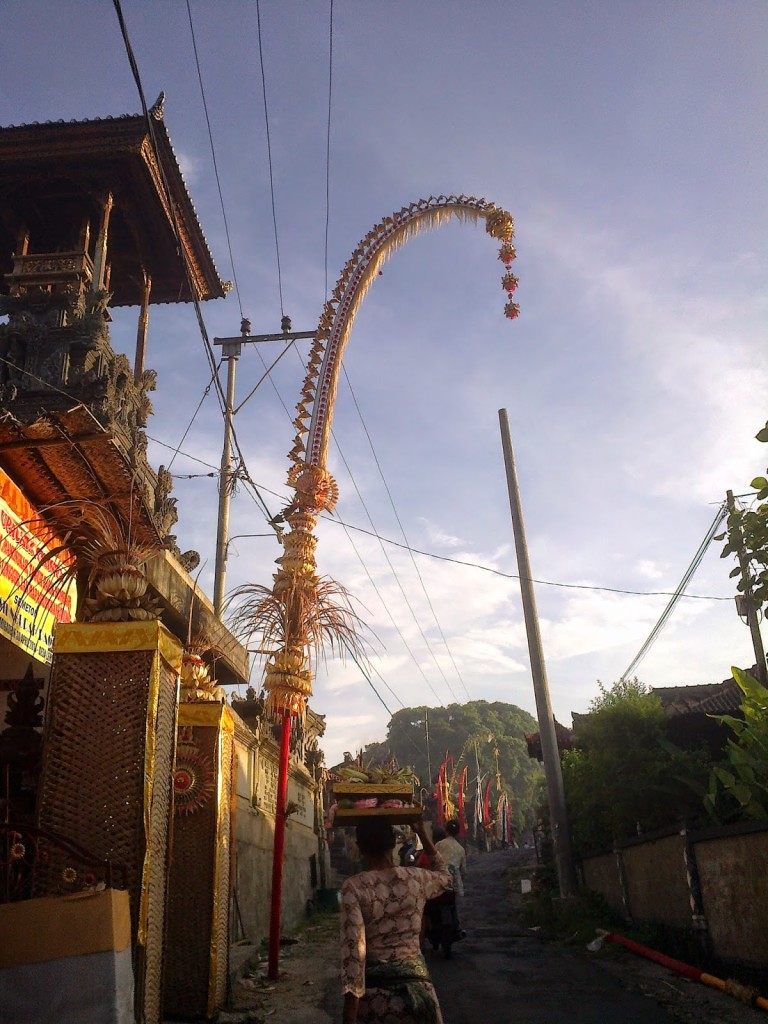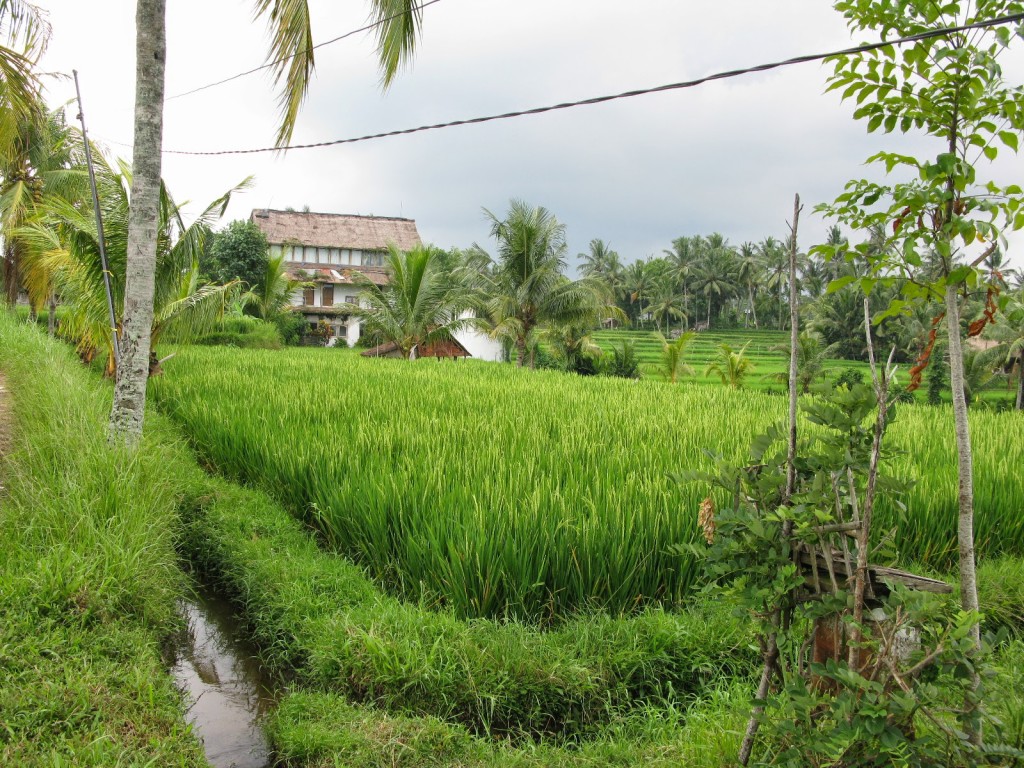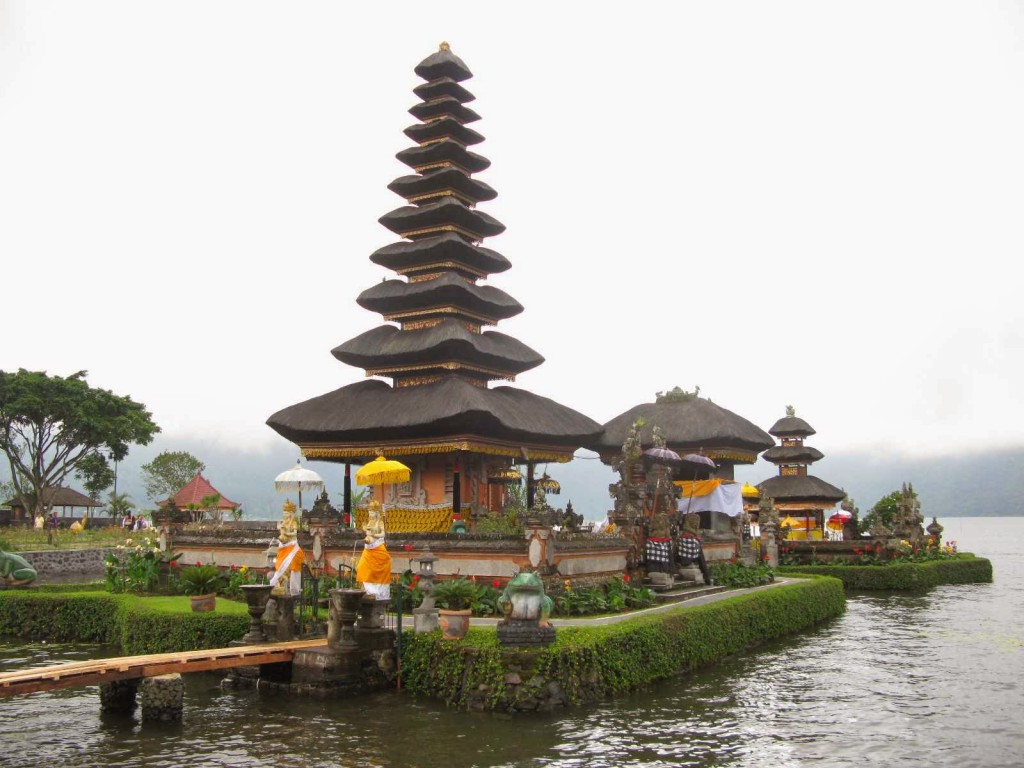Bali – the word conjures up images of white sand and turquoise water. Volcanoes and rice terraces. Tropical flowers and palm trees. Or it did for me. The reality is that it has all these things – plus a gazillion tourists, nose to tail traffic, and a serious rubbish problem. Of course we’d done our research, so we avoided Kuta and its west coast extensions (built up, crowded, and a beach that’s better for surfing than swimming). A recent photo of garbage carpeting Jimbaran beach put us off going there, and the coves of the Bukit peninsula seemed a bit isolated unless you had transport – and our first priority was access to a dentist. So we opted for Sanur, Denpasar-on-Sea almost. The fact that its nickname among the surfer crowd is ‘snore’ seemed like a recommendation.
At first glance I wasn’t enamoured – a hot main street of restaurants, hotels and tourist-oriented shops, all more expensive than Yogya. But the hotel was decent and very reasonable considering that it came with a fridge, kettle, DVD player and a dozen English language TV channels. And air con of course – at the moment it’s the first thing we look for because of the humidity.
Dental matters were quickly dealt with – the 911 clinic in Denpasar (actually named for its street number but rather apt) caters to a constant stream of mainly Australian dental tourists, for whom the cost of a 4 hour flight is more than offset by treatment costing a fraction of what they’d pay at home. Our taxi delivered us about 20 minutes before Mr V’s appointment, but he was whisked straight through to one of their 40+ treatment rooms where a dentist prescribed a filling before handing over to a dental nurse to complete the work in double quick time. At £30 it was about 4 times what it would have been in Goa – perhaps the Aussies should consider a longer flight.
From what we saw of Denpasar it held little of interest, with the exception of what I will call Nursery Street – for what seemed like several miles, one side of the road into the town was flanked by an unbroken row of garden centres, all selling an identical array of bougainvilleas, frangipani trees and assorted potted plants. In a place where it might be expected that tropical plants would just propagate naturally and flourish unaided, it was a surprise to see so many plants for sale. I hadn’t at that stage realised the need for every garden to have at least two or three frangipani trees, whose flowers would be harvested daily by the woman of the household and placed in a little basket of woven palm leaves along with an incense stick, cooked rice, moss, a little biscuit and anything else they think will please the spirits.
Every morning these offerings are placed on shrines, walls, doorsteps and footpaths – an ordinary household might need as many as 20, and even more need to be made on special days, such as the new or full moon, to be taken to the temple. The amount of time that a Balinese woman spends weaving little baskets must add up to several years over her lifetime, even though the judicious use of a stapler speeds up the process. When the daily offerings are made the woman first dons a sarong and ties a sash around her waist – this traditional garb is required for all men and women visiting a temple (and men must also wear a jauntily tied headcloth). On special days children even go to school in traditional Balinese dress – and special days seem to occur every week.
Once we’d dealt with the dental issue we could settle down to enjoy Sanur. The beach wasn’t bad – at least it was clean and the water clear, and the offshore reef keeps the waves gentle and the aspect turquoise. A paved walkway runs the entire length of the shore and for people like us, who are not staying in a beachfront resort, a few warungs rent out sunbeds. Sure, it was touristy, and the constant entreaties from stallholders and massage purveyors were irritating, but it was all fairly low key. With a fridge that enabled us to enjoy cold beer at retail prices, and a kettle that facilitated money-saving pot noodle lunches, it was fine for a few days. My main gripe with the place is that it straggles along the coast without a coherent centre, and with the Hyatt hotel occupying a huge chunk of beachside real estate between the southern end and the central area, I felt a bit stuck out on a limb. But in reality there was probably nothing different in the central area, and when we needed to go to the northern end to suss out boat services and buy a bus ticket we took a bemo.
I suppose the nearest equivalent to a bemo is a collectivo, a minibus that plies a certain route picking up and dropping passengers wherever they want. But every collectivo I’ve been on before had proper seats and a sign to indicate its destination. This had neither – in fact, unless you had read up on it, you could completely miss the fact that shabby green minibuses are public transport in Sanur. There are no destination signs because they all follow the same route, and the seats are just padded benches along each side, barely 10″ off the floor, with the door so low that you had to sit on the floor to get out.
Bemo would have been the cheapest way to get to Ubud, about an hour away, but we took the Perama shuttle bus. We didn’t fancy sitting with our knees by our ears for that length of time. Taking into account the cost of a taxi at either end, since the Perama office is not very central in either Sanur or Ubud, it would probably have been almost as cheap to get a taxi all the way. I’d had an image of Ubud as an idyllic small town surrounded by countryside, but we seemed to arrive without ever really leaving the suburbs of Denpasar and the traffic barely thinned. I think my image was a little out of date – like, 30 years out of date maybe.
But we found that the daytripping throngs disappeared with the sunlight, and crossing the road in the evening became less of a challenge. Our hotel, the Pering Bungalows, had been difficult to locate, but its location tucked down an alleyway off Monkey Forest Road ensured a degree of tranquillity that accorded well with the view from our balcony – frangipani trees, a small swimming pool and clouds permitting, a distant view of a volcanic cone. Walking around Ubud we learned to look past the Ralph Lauren shopfronts and saw that there is still a tremendous amount of traditional architecture and stonework there. A temple with a lotus-filled pond lurked behind a Starbucks. Elaborately carved doorways and arches are everywhere – even the doors of our hotel room were intricately carved, the design picked out in blue, red and gold paint.
The unique culture of Bali is not something that has been consigned to museums, or just brought out on special occasions – it permeates everyday life. Buildings that we thought were temples turned out to be houses, their gardens filled with ornate stone or thatched wooden shrines (maybe a dozen or more) housing the spirits of their ancestors and honouring the gods. Many of the shrines take the form of an empty chair, symbolising the nameless, formless supreme god, of whom all the other gods are merely manifestations – at least it was nameless until Christian missionaries came and gave them a name for the Christian God, which they adopted for their own, thus happily ensuring that Hinduism qualifies as a monotheistic religion eligible for equal status with Islam, Judaism, Christianity and Buddhism, under Indonesia’s constitution.
If a house has no garden, there will be at least one shrine on the roof, adorned with a black and white check umbrella and hanging decorations made from bamboo strips. Gates are marked with a penjor, a tall decorated bamboo pole that bends over at the top, from which is hung a sampian, a construction of palm leaves that looks like a lantern or tassel. Black and white check cloth is tied around pillars, trees, statues – anywhere that a spirit is thought to reside. The black and white is symbolic of … something. If you thought Indian Hinduism was complex, the Balinese version beats it hands down.
Art is everywhere in Ubud, but there is no word for ‘artist’ in Balinese, because in the past carving, painting, or playing a musical instrument was just what everybody did when not working – not something that you could do as a profession. Some of the art produced for the tourist market is complete dross, but some shows incredible skill. A young man of about 19 appeared on our balcony as we were having breakfast one morning, claiming to want to practise his English. He was training to be a chef, but as a hobby he produced painted wooden eggs – and of course he just happened to have a few on him, should we be interested in buying one. We weren’t, but the beautifully executed intricate traditional designs were worthy of an experienced professional.
We also discovered that while there is development all along Ubud’s arterial roads, behind the buildings lie rice fields as green and rural as you could want. A raised pathway alongside a gurgling stream took us out among them, and suddenly we were in the kind of landscape that would once have been found all over southern Bali – before Denpasar, Sanur, and the Kuta-Legian-Seminyak strip all merged into an urban sprawl.
Having decided that the beaches of Bali’s north coast were probably not worth the trek, we still wanted to see more of the landscape, so for the price of two seats on a coach tour (which were all too long anyway) we chartered a taxi for the day. We drove north east first, to Jatuwulih on the slopes of Mount Batukaru. North of Ubud the countryside starts – areas of rice where it’s flat, tracts of trees where steeply sided streams cut through. Small villages, with perhaps a small shop and a warung to service the cluster of houses. Vivid gardens of frangipani, hibiscus and bougainvillea, and even the road verges sport ‘houseplants’ – crotons, bird’s nest ferns, rubber plants and bromeliads.
As we reach the slopes of the extinct volcano the road becomes more twisting and bumpy, until we round a corner and get our first glimpse of proper rice terracing. A little further on the residents have set up a toll point – fair enough, if tourists are causing wear and tear on their road, some compensation seems reasonable, and it appears to keep the area reasonably free of hawkers and tourist tat – just a couple of restaurants (upmarket warungs really) and two women selling water and snacks by the viewing point. The landscape is a UNESCO heritage site, and it deserves its accolade.
From the viewing point, which we shared only with a group of lycra-clad Indonesian cyclists, a patchwork of immaculately maintained terraces of rice, mostly with formed seed heads but still bright green, a few with seedlings standing in water, stretches for miles downhill. Most fields have a small tiled hut in the corner, and when we walked along the path from the viewing point we realise that each houses a solitary, tethered, Jersey-type cow. It can’t be much fun for them, but I suppose they can’t be allowed to tramp around in the rice, and they need the shade. I’m just a bit surprised to see them at all, since there seems to be no tradition of dairy produce in the Indonesian diet and in Bali, beef only seems to feature on tourist restaurant menus.
After viewing our fill we headed back down the road – by this time the minicoaches were starting to arrive, so I was glad we’d set out early. Climbing again, higher this time, we rounded the shoulder of the volcano and dropped down into the botanical gardens at Candikuning, where we planned to spend a couple of hours. The gardens were nice enough, especially the wild orchid section (the forebears of the cultivars are surprisingly unshowy) and the cactus house, but it didn’t compare well with the one in Singapore, and unfortunately it started to rain. Back at the car park we munched down our budget-conscious Kraft cheese slice sandwich before continuing to Ulun Danu, a lakeside temple. Unexpectedly there was a Rp30,000 entrance fee, which seemed a bit steep just for a closer view of the outside (you can’t go inside). Mr V took a few photos from the gate and we went to look for our driver – and in the process we accidentally wandered in through the unmanned exit to the temple grounds. Oops! So we got the full experience after all, for what it was worth (and it wasn’t worth Rp60,000).
The drive straight down the main road back to Ubud was tedious – pouring rain, increasing urbanisation, then a traffic jam caused by drainage improvement works. It should have taken an hour and took two. Never mind, I was still glad we took the trip – although if we had crossed East Java by train as we originally planned, it probably wouldn’t have been so worthwhile.
We were still a bit undecided about where we would go after Ubud, so headed for Padang Bai, a small ferry port on the east coast. From there we would have the choice of going to the Gilis (off NW Lombok) or Nusa Lembongan, one of three islands SE of Bali. Lembongan won, partly for financial reasons, but also because we thought we might return to Indonesia to visit Lombok and points east. We had a couple of days in Padang Bai before our boat left, which we needed in order to assemble sufficient cash. For a three weeks stay, plus the boat fare, we would need about Rp17 million. There is only one cashpoint on Lembongan, and it doesn’t take Visa affiliated cards – and we only have one credit card that is Mastercard, which is expensive to draw cash on. So we repeatedly visited the cashpoint in Padang Bai to draw out the maximum Rp1.2 million each (all of £60!) hoping that the bank wouldn’t decide that this constituted unusual activity and stop our cards. Luckily we found a cashpoint dispensing Rp100,000 notes, the largest note in circulation, and persuaded a bank to swap the few million in Rp50,000 notes that we had already drawn out in Ubud – the pile was too fat to fit in our moneybelts.
Padang Bai is a sleepy little place once the Gili-bound hoards have passed through (seriously, the Gilis must be heaving), but sadly the beach is dirty and the water unswimmable (too many boats, apart from the dire water quality). The hotel/bar staff kept pushing the white sand beach just over the headland to the west, so we decided to go. A steep, hot climb up a track and down an even steeper path was rewarded with what at first looked like a picture perfect crescent of white sand lapped by turquoise water and backed by a few simple warung. Unfortunately a closer inspection revealed bits of garbage along the water line, and after about an hour a large raft of rubbish drifted into the shallows, driving us out of the water. The warung owners tried to clear what was deposited on the sand, but it was clear that the raft would not move on until the tide turned, so we made the trek back to the hotel in the searing midday sun.
Bali really needs to get a grip on its refuse problem – everyone just chucks stuff onto the nearest bit of spare ground, so of course the rain washes it out to sea and it ends up on the beaches. At least one Balinese government spokesman puts the blame on tourists, but all the litter louts I’ve seen have been local people, perhaps because there are no collection arrangements. Some of the tourist income needs to be spent on waste management, especially plastic recycling – and fast, or tourists may stop coming. But perhaps that would be a good thing – south Bali is fast running out of space (so there are mutterings about abolishing the island-wide building height limit of 33ft) and, more importantly, fresh water. When that happens, it’s game over.













